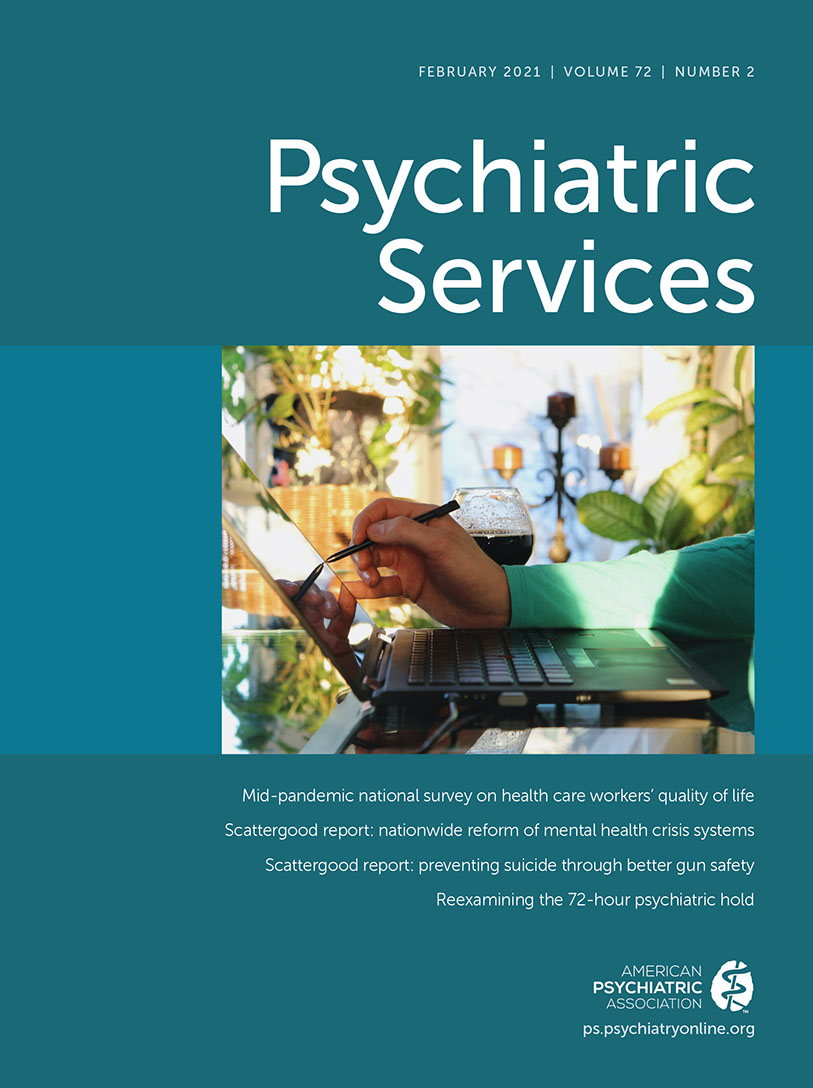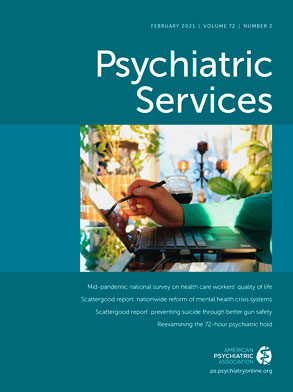Incentives that are poorly aligned with goals, within and across health care systems, often lead to inefficient, suboptimal behavioral health care delivery. To a large extent, this deficit occurs because clinicians and the systems in which they practice are incentivized almost entirely by volume and throughput rather than by quality and outcomes. Traditional payment models, information systems, and treatment paradigms fail to incentivize keeping people healthy, managing chronic conditions, or coordinating care across the continuum of services (
1,
2). This is not an indictment of clinicians, who are clearly motivated to improve the lives of the patients they serve. Nor is it an indication that high-quality work is not happening. Pockets of excellence are all around. A discussion with almost any psychiatrist will yield multiple stories highlighting the positive impact they have had on those they serve, stories that motivate them to continue their work as healers. Yet, despite clinicians’ best efforts, the constraints imposed by misaligned incentives negatively affect system design and lead to widespread defects in care.
Defects in Behavioral Health
We define a defect as anything clinically, operationally, or experientially that a provider would not want to happen, including in diagnosing, initiating treatment, adjusting treatment, nurturing therapeutic alliances at the individual provider and system level, and avoiding preventable service utilization. The term may seem harsh or judgmental to many who first read it, but this is not our intention. To the contrary, inspired by high-reliability medicine (reliability generally refers to the number of defects per opportunity for that defect) (
3), the term “defect
” serves three purposes. First, it highlights that evidence-based behavioral health care has progressed enough that we can construct reliable, standardized pathways of care, across a range of disorders and settings, that can reasonably be expected to produce good outcomes. Second, it adds a new dimension to quality improvement efforts that harmonize personal practice both internally with our behavioral health colleagues and externally across all aspects of health care systems. In doing so, it frames our individual care delivery as being connected to the entire web of services in which patients are embedded. Finally, its simplicity unifies multiple dimensions of the patient and provider experience into one process with one goal—defect-free care—that we believe will empower clinicians to engage in quality improvement initiatives at whatever level is most accessible to them.
A notable saying in quality improvement reads, “Every system is perfectly designed to achieve the results it gets.” A large majority of defects are the result of system failures rather than individual clinician failures. To improve, we need to change the system. Despite our best intentions and efforts, defects happen every day in every field of medicine. Despite clear evidence-based screening tools and criteria for diagnosis, patients are rarely screened appropriately for common behavioral health issues, with barely half of identified individuals having received any care during the prior year and less than 15% having received appropriate evidence-based care (
4). Even when prescribed a medication, only 23% of patients with depression received evidence-based psychopharmacology and appropriate symptom tracking (
5). To further illustrate this point for behavioral health, we provide examples below from personal clinical experiences that we believe most psychiatrists have experienced during their careers.
A patient with major depressive disorder was prescribed a starting dose of 20 mg of fluoxetine and scheduled for a follow-up appointment in 4 weeks. The patient picked up the medication but did not take the first pill for 2 weeks, then took two pills and stopped because of side effects. The patient called the office to report the trouble, but no one answered, and the phone call was never returned because no one checked the voicemail (no one had been assigned to check). When the patient arrived in the office 4 weeks later, the symptoms had not improved, and the patient ended up paying a second copayment of $50 to receive an alternative treatment. The patient described feeling angry with the system for not responding and for necessitating more time and money to receive the alternative treatment. The patient canceled the next appointment and did not return. If we instead made sure someone called patients 1 or 2 weeks after starting treatment and simply asked whether they had picked up the medication, tried it, and were still taking it, might we prevent this kind of outcome?
A patient with schizophrenia was prescribed doxycycline for cervicitis. After taking a dose, she became nauseated and worried that the medication would interact with her risperidone. She went to the emergency department (ED) where she reported having stopped taking her risperidone, leading to a primary diagnosis of schizophrenia with medication nonadherence and a psychiatric admission. Despite recognizing the errors, the covering resident felt the patient needed to be admitted because it was after hours. She was discharged after the weekend. Could we have prevented an ED visit and subsequent admission with more consumer-friendly communication options?
A patient with opioid use disorder was given contact information by his primary care provider for outpatient buprenorphine induction on the opposite side of town. Because of his addiction, he was unemployed and did not have money to fix his car. Public transit required taking three buses for more than 3 hours each way. In acute withdrawal and failing to connect with the provider, the patient visited the ED, where the psychiatrist was able to connect the patient to same-day intake for the same services within a mile of the patient’s home. Could a better process for treatment referral have eliminated the patient’s suffering and prevented an ED visit?
In all three examples, the clinicians provided the right care at the appointment. Despite providers putting in care and effort, defects in the care pathway led to waste, failure to apply the intended treatment, and failure to establish trust in the system. In these examples, good clinical intentions nevertheless delivered low-value results, and extra effort was necessary to remedy the defects. Our observation and experience are that we providers have become so accustomed to working in low-reliability environments that we accept defects in the system as the norm. Indeed, most defects are invisible or are accepted as the cost of caring for patients with complex issues.
Factors Contributing to Behavioral Health Defects
Despite having worked within low-reliability systems, we know what high-value care looks like. Value is the sum of outcomes, patient experience, and clinician experience divided by cost of care (
6). Models that focus on delivering high-value behavioral health care are not new. For example, the collaborative care model (CoCM) has established an evidence-based mechanism for eliminating defects through embedded mental health treatment in primary care practices (
7). Despite 20 years of outcomes demonstrating its validity, however, CoCM adoption has been slow nationally, hampered by a lack of payment mechanisms, organizational barriers (e.g., limited provider time or confusion about who holds responsibility for a patient’s care), and clinical barriers (e.g., provider or patient knowledge) (
8). Thus, although Medicare created and implemented a code in 2018 to pay for CoCM directly (thereby reducing financial barriers), providers still struggle with these other aspects of implementation for which the model does not necessarily provide easy answers.
Meanwhile, the data infrastructure has been slow to develop, largely because data analytics have not yet matured enough at the system level. Even with the advent of value-based payment mechanisms that mandate minimal quality metrics, behavioral health quality assurance and improvement efforts are narrowly focused on the limited set of metrics prescribed by credentialing bodies (e.g., the Joint Commission) or accountable care organizations. (Until this year, the Patient Health Questionnaire–9 screening was the only behavioral health quality metric for Medicare accountable care organizations.) Furthermore, those large-scale incentives provide little guidance for addressing the host of smaller consumer experience defects (e.g., whether patients are able to pick up their prescriptions or whether the postdischarge appointment is for the right intervention with the right provider at the right time).
Development of Value in Behavioral Health
By considering defects at all levels of practice, clinicians reframe their perspective away from simply meeting a minimum standard on a finite number of mandated metrics that may or may not be applicable to their specific clinical domain. Our framework for eliminating defects has three components. First, clinicians must imagine and define what defect-free care looks like. This first step requires leadership to guide clinicians in designing high-quality care at and between every level across a system, not simply in one clinical space at one time. Once that defect-free vision is clear, process and outcome metrics must be identified, and dashboards must be designed to make visible where structural, process, outcome, or utilization metrics are falling short of expectations (
9). Those data must be shared at all levels and across the entire continuum of care. Finally, clinicians must be encouraged and provided with support for changing the system to eliminate visible defects and for analyzing the patient and provider journey to identify previously invisible defects and make them visible.
The job of building and transforming behavioral health at the system level will require psychiatrists to function as systems engineers, adopting a new set of skills and a willingness to think differently about their identity as clinicians. Beyond assessment and treatment skills, psychiatrists who act as systems engineers must be experts in quality improvement, implementation science, resonant leadership, and design-based thinking. No doubt, this role will evolve over time. This work can be accelerated by changing the narrative around defects now.
Most health care resources are devoted to the treatment of acute illness, but defects in care reach beyond that. Wellness must involve not only resolving acute illness but also getting people well (effective management of chronic behavioral illness) and helping them stay well (effective prevention); all are necessary components of health care. Designing a vision for all three levels is essential for high-value care.
Conclusions
Behavioral health care is entering an era in which improvement in outcomes across a variety of indices can be meaningfully measured and tracked. Enhanced analytics have made visible how defects affect value across the spectrum of behavioral health care, and behavioral health clinicians are eager to drive cultural change to eliminate defects.
We believe that our framework to visualize and systematically eliminate defects in behavioral health care ultimately offers a hopeful approach to improving care—one that can drive large-scale success more effectively than trying to pick away at pieces of the system independently or berating clinicians about performance on individual quality metrics. This new narrative, which builds on much of the wisdom accumulated by our field over decades, can succeed only if clinicians see their core responsibility as focusing on eliminating defects and delivering the care that individuals with mental illness and addictions deserve, that clinicians are hungry for, and that payers increasingly demand.

